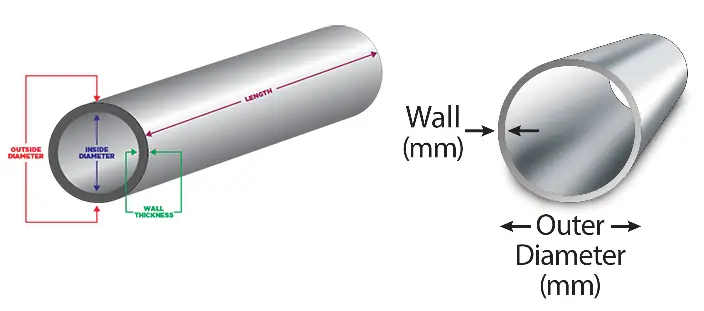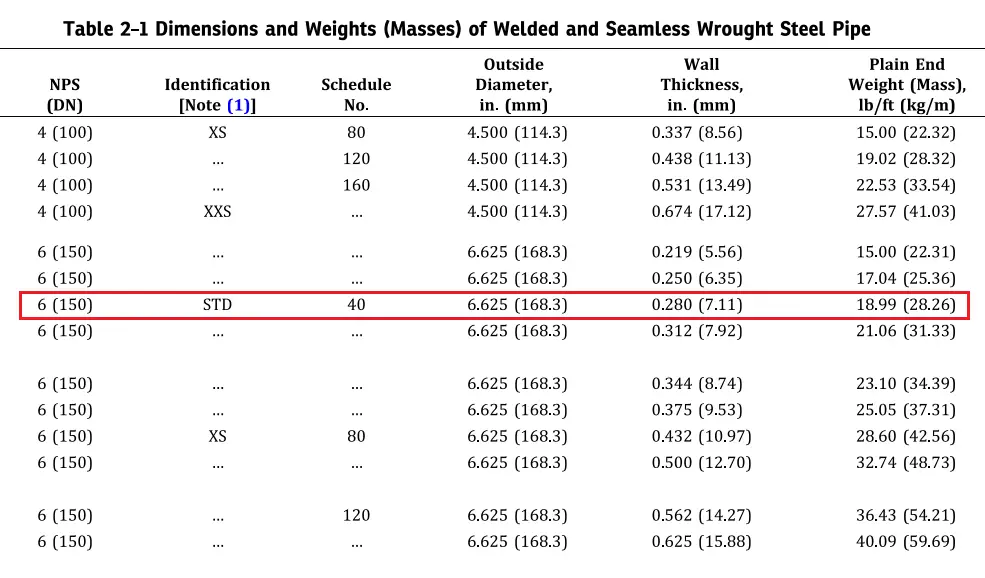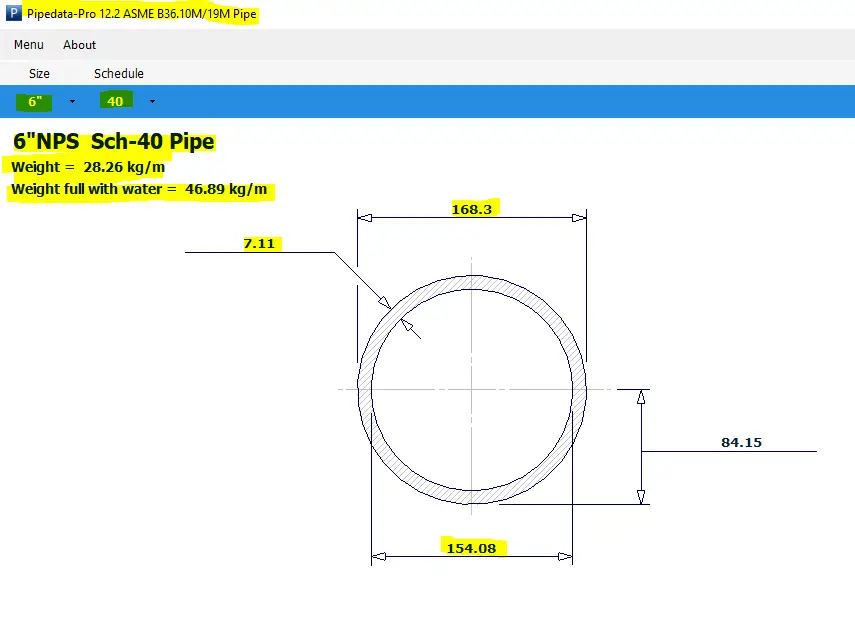Pipe Weight Calculation is a very important process in piping engineering. Pipe weight is directly related to its thickness (Pipe Schedule). The more the pipe thickness or pipe schedule, the more will be the pipe weight. The more the pipe weight, the more will be its rigidity and less flexibility. More pipe weight means more cost of procurement. More pipe weights add more loads on the pipe supports requiring more robust structural member requirements. So, we can say pipe weight is related to overall plant cost in some way. In this article, we will explore pipe weight calculation formulas and methodologies.
Calculating pipe weight is quite simple and fast. The mathematics behind the pipe weight is very easy. The steps and formula for pipe weight calculation are explained below:
Pipe Weight Calculation Formula
To calculate the mass of any object we can use the following formula
Mass (M)= Density (D) X Volume (V) …(eqn. 1)
Pipe weight is also calculated using the same equation. Pipe weight is normally expressed in Pipe Weight per meter of length or Pipe Weight per foot of length. Also, there are two other terms associated with pipe weight calculation. These are
- Empty Pipe Weight Calculation and
- Water-Filled Pipe Weight Calculation.
Empty Pipe Weight Calculation
Empty pipe weight means pipe weight without any content inside it. So, it is the weight of the metal present in the pipe. Refer to Fig. 1 below:

So following eqn. 1 above we have to calculate the volume (V) of the pipe first and then we have to multiply the calculated volume by pipe material density (D) in a consistent unit. To calculate the volume of the pipe we need the following parameters:
- Pipe Outside Diameter (OD) (Obtained from ASME B36.10M / ASME B36.19M)
- Pipe Thickness (T) (Obtained from ASME B36.10M / ASME B36.19M), and
- Length of Pipe (=1 as pipe weight is expressed in pipe weight per unit length)
- The inside diameter (ID) of the pipe can easily be calculated as ID=OD-2T
- Pipe Metal Cross Section is calculated as Π (OD2-ID2)/4
The volume (V) of the pipe is calculated as V=Pipe metal cross-sectional area X length of pipe = {Π (OD2-ID2)/4} * 1
CS Pipe Weight Calculation in Kg/m
Let’s calculate the weight of a 6-inch CS pipe with Sch. 40 as pipe thickness. From ASME B 36.10M
- Pipe OD=168.3 mm
- Pipe Thickness=7.11 mm
- Hence, ID=168.3-2*7.11=154.08 mm
- Metal Cross Sectional Area=(Π)*(168.32 – 154.082)/4=3600.4565 mm2
- So volume for a unit length of pipe=3600.4565 * 1= 3600.4565 mm3 =(3600.4565/1000000) =0.0036004565 m3
So now we have to multiply this volume by CS pipe density (7850 kg/m3) to get the actual weight of 1 m of pipe length.
So the Metal weight of 1 m of Pipe length=0.0036004565*7850=28.26358356 Kg.
To calculate the pipe weight for lengths more than 1 meter, simply multiply the above value by the actual length of the pipe.
Similarly, we can calculate an empty pipe weight per foot of length by considering all the above values in a consistent FPS unit system.
Water-Filled Pipe Weight
Water-filled pipe weight is required to calculate the loads during hydro testing. For the structural supporting design of non-critical lines, pipe loads are calculated or approximated based on water-filled pipe weight.
To calculate the content (water) weight inside the pipe we have to multiply the water density (1000 Kg/m3) with internal pipe cross-sectional volume 1*(Π * ID2)/4.
For the above pipe under consideration, the internal pipe cross-sectional area=Π*154.082/4=18645.86008 mm2=18645.86008/1000000=0.01864586006 m2
So the weight of water content inside the pipe per meter of length=1000*0.01864586006=18.64586 Kg/m.
Now add this content weight with the metal pipe weight to get the total water-filled pipe weight. So,
Water-filled Pipe Weight (Kg/m)=Weight of empty pipe (Kg/m)+ Weight of Content (Kg/m)
In the above example, Water filled pipe weight=28.26+18.65=46.91 Kg/m
By simply multiplying the above value (46.91 Kg/m) by the actual pipe length you can calculate the water-filled pipe weight in Kg.
Pipe Weight Calculator
I have prepared one Pipe weight Calculator in kg/m using the above-mentioned steps and attached it here for your consideration. The metric unit system is used in the Pipe Weight Calculator excel-sheet. Simply, input your data in yellow highlighted boxes and get the actual calculated values at ease.
You can download the pipe weight calculator by clicking the download button shown below.
The following inputs will be required for using the above pipe weight calculator or any other online pipe weight calculator:
- Pipe Outer Diameter
- Pipe Thickness
- Density of Pipe Material
This Pipe Weight calculator can be used to calculate the weights of any piping material by changing the pipe density to the corresponding pipe material density. So Steel pipe weight, Cast iron pipe weight, PVC pipe weight, Copper pipe weight, GRE Pipe Weight, Aluminum Pipe Weight, etc. can easily be calculated using the attached Pipe Weight calculator.
The above-mentioned pipe weight calculation steps are suitable for round pipes. However, as pipes are available in square and rectangular shapes, the methodology for pipe weight calculation for square or rectangular pipe will be different in the way the metal cross-sectional area will be calculated. However, the basic pipe weight calculation equation as mentioned in Equation 1 will still be valid.
Density of Common Pipe Materials to Use in the Pipe Calculation Formula
As you can see, pipe density is one of the most important parameters used in the calculation of pipe weight. Table 1 below provides the density of some of the common pipe materials as a ready reference
| Pipe Material | Approx. Density (Kg/m3) | Pipe Material | Approx. Density (Kg/m3) |
| Carbon Steel | 7850 | Bronze | 8800 |
| Stainless Steel | 7700 | Titanium | 4540 |
| Aluminum | 2700 | Cast Iron | 7000 |
| Brass | 8600 | Nickel | 8900 |
| Copper | 8920 | PVC | 1450 |
Pipe Weight Calculation for Square and Rectangular Pipes
For a square pipe with a length of side A and thickness t, the metal cross-sectional area will be {A2-(A-2t)2}. Once you calculate the metal cross-sectional area, multiply it by the pipe material density to find the weight per unit length of the square pipe.
In a similar way, the metal cross-sectional area for a rectangular pipe with length A, width B, and thickness t can be calculated as [A*B-{(A-2t)*(B-2t)}]. So, once it is found, multiply with pipe density to get pipe weight per unit length of rectangular pipe.
Steel Pipe Weight Chart
For Carbon Steel and Stainless Steel pipes, the pipe weight per foot or pipe weight per meter of length can easily be taken directly from the Steel Pipe Weight Chart Provided in ASME B36.10M (For Carbon Steel) or ASME B36.19M (For Stainless Steel).
Those two ASME codes provide the Steel pipe weights directly in their tables as pipe weight per foot or pipe weight per meter of length. Part of the table from ASME B36.10M for a 6-inch line that we considered above as an example is produced here to explain the chart.

As you can see, the empty pipe weight that we calculated for the 6-inch Sch. 40 pipes matches exactly the value provided in the above ASME Code.
However, the above steel pipe weight chart provides only the empty pipe weight value directly. Water-filled pipe weight you have to manually calculate using the above procedure.
Pipe Weight Calculation using Pipedata-Pro
Both Empty pipe weight and Water-filled pipe weight can easily be obtained if you have Pipedata-Pro software. That software directly gives the pipe weight values of all pipe sizes corresponding to pipe thicknesses. Fig. 3 shows the sample pipe data-Pro Screenshot for the 6-inch Sch. 40 pipes that we considered in our pipe weight calculation.

The above values show the pipe weight in Kg/m. However, You can easily change the unit if you need data for Pipe weight per foot.
Video Tutorial on Pipe Weight Calculation
The following video tutorial clearly explains all the steps required for pipe weight calculation
How do you find what is the weight of your round pipe?
To calculate the weight of your round pipe, Follow the below-mentioned steps
Step 1. Find the volume of the pipe using the following equation; volume = 0.785398 × [(Pipe Outer diameter)² – (Pipe Outer diameter – 2*thickness)²] × length
Step 2. Multiply the pipe material’s volume calculated in step 1 by the pipe material density. Hence, Pipe weight = volume × density









Thank you Sir, for your information
Dear Anup, thanks a lot for this and all great post.
Sir,
very good informative blog. kindly continue to maintain. you will doing educating millions . may god bless you. Thank you very much.
Dear Anup I’m very impressed with your post and knowledge . kindly share more information about construction and installation.
Thanks
Regards
Mohammad Aamir Arafat
What about Clay Pipe Weight Calculations?
Fired Clay pipe and Wet Clay pipe?
Dear Anup.
Great information,
I am trying to get the correct weight of an 8 ” 12 meter pipe with .280 wall thickness
Thank youRiyaz
What if asked to calculate the mass of concrete coating, pipe and contents?
do you just add everything together?
given the pipe and coating thickness and density as well as density of content?
Thank you Anup, the information in this post was very useful!
How can I calculate pipe weight with corrosion allowance during installation, hydrotest and operation cases?
Thank you.
MS PIPE LINE REDUCER CALCULATION CAN EXPLAIN 2.5 M LENGTH 711 TO 813MM ,7.1MM THICKNESS ASPRACTICALLY AT SITE
good knowledge